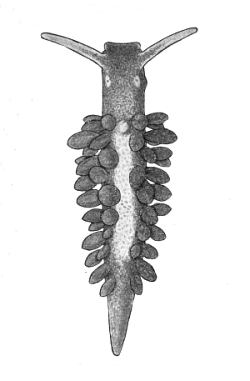
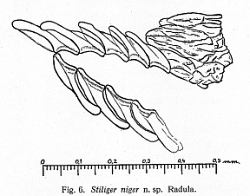
Ercolania nigra
(Lemche, 1935)
Order: SACOGLOSSA
Superfamily: LIMAPONTIOIDEA
Family: Limapontiidae
DISTRIBUTION
Known only from Denmark?
PHOTO
Original figures from Lemche (1935). Fig. 6.: Eastern part of Nyborg fjord, Funen, Denmark. Very shallow water (0,2-0,3 m. depth), in Cladophoraceae. Oct. 19, 1929.
Total length of the living animal 7-8 mm. The colour of these animals is greenish-black, head and foot lighter greyish. The rhinophores, the tail, and the elevated part of the back are whitish, the back, however, showing a number of pigmented spots. The lightest parts are sprinkled with small opaque white dots, and some white dots are also scattered over the back. The cerata are of a greenish-black, although not quite so dark as the body and interspersed with lighter spots. Through the skin two liver-branches are faintly seen running backward under the narrow space between the light field on the back and the innermost cerata. The branches give off smaller branches to the cerata.
The radula consists of a single row of spoon-shaped teeth of which four are situated in the ascending and five in the descending part of the row.
See message below for full original description. See also Kathe Jensen's message comparing this species with Ercolania funerea. Originally named Stiliger niger, the species name changes to nigra because of grammatical rules, Ercolania being feminine and Stiliger masculine.
-
Lemche, H. M. (1935). On some nudibranchiate gastropods from the northern Atlantic. Videnskabelige Meddelelser fra Dansk Naturhistorisk Forening, 99: 131-148. [Note: although whole volume was not published until 1936 - reprints were distributed in 1935].
Rudman, W.B., 2002 (November 7) Ercolania nigra (Lemche, 1935). [In] Sea Slug Forum. Australian Museum, Sydney. Available from http://www.seaslugforum.net/find/erconigr
Related messages
Re: Calliopaea bellula - Ercolania cf. viridis & eggs
April 1, 2009
From: Kathe R. Jensen
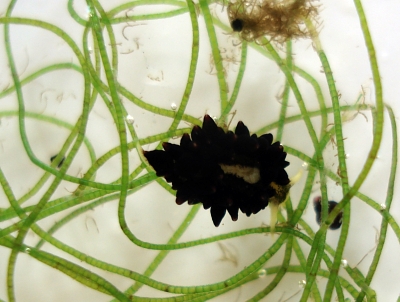
Concerning message #22366:
Dear Bill and Marina,
I was surprised to see the dark variety of Ercolania viridis [= E. funerea]. This gives me an opportunity to share some pictures I took of Ercolania nigra from northern Kattegat during a student field trip in September 2006. I only had my pocket camera, so magnification is not very good. However, the ventral shot shows the pigmented band on the foot sole, which occurs in most specimens and which I cannot see in Marina's specimens nor in the photos from the Black Sea.
Locality: northern Kattegat, 0.5m, Denmark, NE Atlantic, 15 September 2006, sheltered sand flat with lots of drift Chaetomorpha. Length: approx. 3-4 mm. Photographer: Kathe R. Jensen.
Marina, if you have a chance of preserving a few specimens of both Ercolania viridis and Calliopaea bellula, I would be very grateful. I need specimens of C. bellula for comparison with C. oophaga to establish the synonymy.
Thanks in advance,
Kathe
krjensen@snm.ku.dk
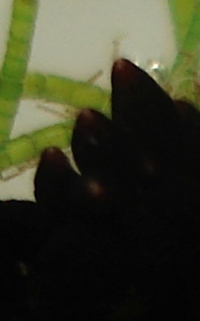
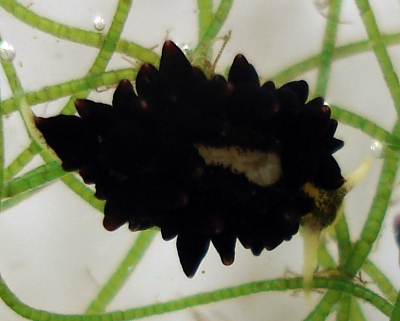
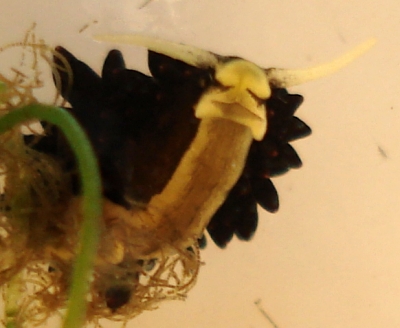
Thanks Kathe,
Its good to get some photos of north Atlantic animals which match Lemche's E. nigra. Is it just a trick of the light in your photos or can I see an orange tip to the cerata, which would make them identical to the animals from the Mediterranean that you previously identified as Ercolania viridis [= E. funerea] [see message #8315]?
The other problem is that you seem to have missed my comment that it seems Marina's species [green and black forms] is different from the earlier Mediterranean animals which were identified as Ercolania viridis, both in general colour and in shape of the egg mass. In Marina's species the cerata have a whitish tip and whitish pustules all over them while in the 'other species' there is an orange tip to the cerata and no sign of whitish pustules. You can see the extremely different egg masses between Marina's species (with small sausage-shaped masses with relatively few eggs), and the orange-tipped species with a large sinuous flattened egg ribbon with many eggs.
If your northern species doesn't have orange tips it still means that there appear to be two species in the Mediterranean. I would appreciate your comments.
Best wishes,
Bill Rudman
Information on Ercolania nigra
November 9, 2002
From: Bill Rudman


Since I can't find any recent description of Ercolania nigra here is Lemche's original description.
Stiliger niger n. sp. (Figs 5,6)
Locality: Eastern part of Nyborg fjord, Funen, Denmark. Very shallow water (0,2-0,3 m. depth), in Cladophoraceae. Oct. 19, 1929.
Description: Total length of the living animal 7-8 mm. Body slender, head quadrangulate in front. Rhinophores long and slender, a little conical, nearly twice as long as the breadth of the body, somewhat compressed near the base. Each of them continues in a low crest running down to the fore-angles of the head. The distance between the bases of the rhinophores is nearly equal to the breadth of the head. A little behind each rhinophore an oval, light spot appears containing the very distinct eyes. The first rows of cerata are situated somewhat behind the eyes. The five foremost rows on each side contain three cerata each, the following four rows consist of two cerata each, and the last row possesses only one.
Thus there are generally ten rows of cerata on each side. The cerata are pear-shaped when extended and nearly globular when contracted. They are all fastened to the body by a short peduncle. As usual the largest cerata are found nearest to the middle of the back, their size diminishing laterally and posteriorly. However, the cerata seem to be inclined to break off, especially on some of the individuals in which they are small and apparently in regeneration. The cerata are density set so that on the living animal they are generally touching each other. The middle part of the back is free and possesses an elongate, somewhat elevated and irregular field covering most of the free part of the back. Anteriorly this field is limited by a small, light tubercle on which the renal opening is found. The tail is rather broad and ends abruptly. Anus is situated on the right side below the first row of cerata- the genital apertures are to be found just below the right eye. The mouth-disc is oval but variable in shape. The foot is narrower than the body, the foot-angles are rounded and only slightly extended.
The colour of these animals is greenish-black, head and foot lighter greyish. The rhinophores, the tail, and the elevated part of the back are whitish, the back, however, showing a number of pigmented spots. The lightest parts are sprinkled with small opaque white dots, and some white dots are also scattered over the back. The cerata are of a greenish-black, although not quite so dark as the body and interspersed with lighter spots. Through the skin two liver-branches are faintly seen running backward under the narrow space between the light field on the back and the innermost cerata. The branches give off smaller branches to the cerata.
The radula consists of a single row of spoon-shaped teeth (Fig. 6) of which four are situated in the ascending and five in the descending part of the row. Further, about a dozen old teeth lie in the ascus at the end of the descending part of the radula. The teeth are somewhat more slender than those ofStiliger bellulus, with a rounded base and a slightly curved tip. A cavity in the hind side of each tooth enables the teeth to fit into each other.
From the other Northern Atlantic species of this genus, Stiliger bellulus d'Orb., the new species diverges especially in the following points:
Stiliger bellulus d'Orb. - Two cerata in the largest rows; About five rows of cerata; Radula consisting of about 15 teeth; Spawn with two or three slender coils; Spawning season at Nyborg: July.
Stiliger niger n. sp. - Three cerata in the largest rows; About ten rows of cerata; Radula consisting of about 9 teeth; Spawn with only one single broad coil; Spawning season at Nyborg: October.
Reference:
• Lemche, H. M. (1935). On some nudibranchiate gastropods from the northern Atlantic. Videnskabelige Meddelelser fra Dansk Naturhistorisk Forening, 99: 131-148. [Note: although whole volume was not published until 1936 - reprints were distributed in 1935].
